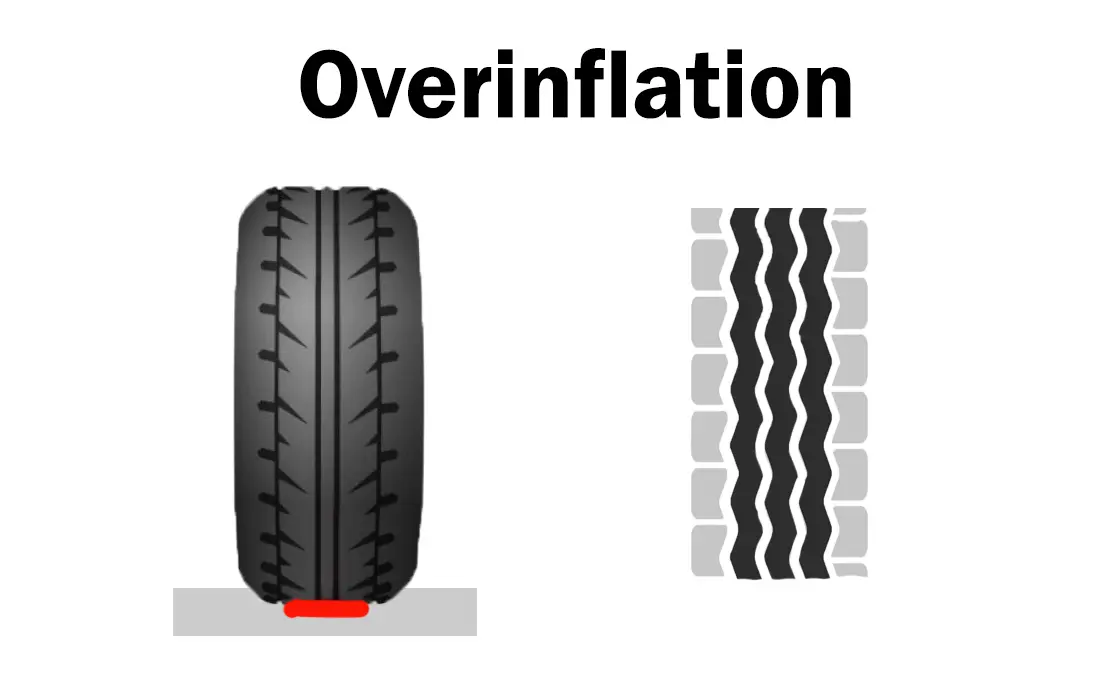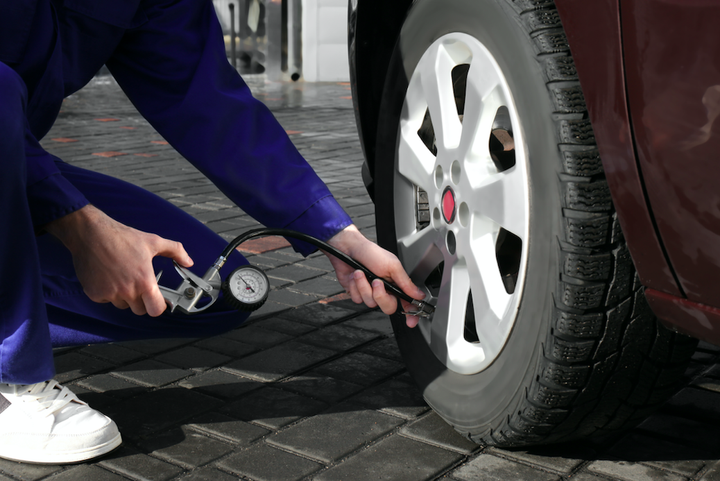


Maintaining proper tire inflation is a critical aspect of vehicle maintenance that is often overlooked by many drivers. Overinflating your tires, even by a seemingly insignificant amount like 5 PSI (pounds per square inch), can have severe consequences on various aspects of your vehicle's performance, safety, and tire longevity. This comprehensive article aims to provide an in-depth analysis of the risks associated with overinflating tires by 5 PSI, equipping you with valuable insights and practical advice to ensure a safe and comfortable driving experience.

Every vehicle manufacturer meticulously determines and specifies a recommended tire pressure range tailored to the specific make and model. This crucial information is typically found in the owner's manual or on a sticker located on the driver's side door jamb. Deviating from the recommended pressure can have adverse effects on various aspects of your vehicle's performance and safety, as outlined in the following table:
| Aspect | Effect of Overinflation |
|---|---|
| Traction and Handling | Reduced contact patch with the road surface, leading to decreased traction and compromised handling capabilities, especially in wet or icy conditions. |
| Tire Wear | Excessive wear in the center of the tread, resulting in premature tire replacement and increased ownership costs. |
| Ride Comfort | Reduced flexibility and inability to absorb road imperfections, leading to a harsher and more uncomfortable ride. |
| Safety Systems | Potential compromise of advanced safety systems like anti-lock brakes (ABS) and traction control, which rely on accurate tire pressure readings. |
Tire pressure plays a crucial role in determining the tire's contact patch with the road surface. The contact patch is the area of the tire that actually touches the ground, and its size directly impacts traction, handling, and overall grip. When tires are overinflated, the contact patch becomes smaller, reducing the tire's ability to maintain optimal traction and handling characteristics.
While 5 PSI may seem like a minor deviation from the recommended pressure, it can have significant impacts on various aspects of your vehicle's performance and safety.
Overinflated tires have a smaller contact patch with the road surface, resulting in reduced traction and compromised handling capabilities. This effect is particularly pronounced in wet or icy conditions, where maintaining optimal traction is crucial for safe maneuvering and braking. The reduced contact patch also affects the tire's ability to grip the road during cornering or sudden maneuvers, potentially leading to loss of control or increased stopping distances.
Overinflation causes the tire to become more rigid and less able to absorb impacts from potholes, debris, or other road hazards. This increased rigidity can lead to a higher risk of blowouts or sudden tire failures, which can be extremely dangerous, especially at high speeds.
A blowout can cause the driver to lose control of the vehicle, potentially resulting in a serious accident. Additionally, the sudden loss of air pressure can cause the tire to separate from the wheel, posing a hazard to other vehicles on the road.
Overinflated tires tend to wear excessively in the center of the tread, a condition known as "center wear." This uneven wear pattern can lead to premature tire replacement, as the tread depth may become insufficient for safe operation before the tire's expected lifespan.
Uneven tread wear can also compromise the tire's ability to disperse water effectively, increasing the risk of hydroplaning in wet conditions. The following table illustrates the potential consequences of uneven tread wear:
| Consequence | Description |
|---|---|
| Premature Tire Replacement | Excessive wear in the center of the tread can lead to the need for premature tire replacement, increasing ownership costs. |
| Reduced Traction in Wet Conditions | Insufficient tread depth can compromise the tire's ability to disperse water effectively, increasing the risk of hydroplaning. |
| Compromised Handling and Stability | Uneven tread wear can affect the tire's contact patch and grip, potentially compromising handling and stability. |
The reduced flexibility of overinflated tires can result in a harsher, more uncomfortable ride. Overinflated tires are less able to absorb road imperfections, such as potholes or bumps, transferring more of the impact to the vehicle's suspension and ultimately to the occupants. This can lead to increased fatigue during long drives and may even contribute to back or neck discomfort for some individuals.
Many modern vehicles are equipped with advanced safety systems, such as anti-lock brakes (ABS) and traction control, which are calibrated to work optimally with the recommended tire pressure. Overinflation can potentially compromise the effectiveness of these systems, as they rely on accurate tire pressure readings to function correctly.
For example, an overinflated tire may cause the ABS system to engage prematurely or fail to engage when needed, potentially increasing stopping distances or reducing control in emergency situations.
It's important to note that tire pressure can fluctuate with temperature changes. As temperatures rise, the air inside the tires expands, increasing the pressure. Conversely, colder temperatures can cause the air to contract, reducing the pressure.
To ensure accurate tire pressure readings, it's recommended to check and adjust the pressure when the tires are "cold," typically in the morning before driving or after the vehicle has been parked for several hours. Checking and adjusting tire pressure when the tires are hot from driving can lead to inaccurate readings and potentially overinflation.
The following table illustrates the relationship between temperature and tire pressure:
| Temperature Change | Effect on Tire Pressure |
|---|---|
| Increasing Temperature | Air inside the tires expands, increasing the pressure. |
| Decreasing Temperature | Air inside the tires contracts, reducing the pressure. |

A common misconception is that overinflating tires can improve fuel efficiency. However, this is not true. While underinflation can increase rolling resistance and negatively impact fuel economy, overinflation does not provide any significant fuel savings.
In fact, overinflation can lead to other issues, such as reduced traction, increased wear, and an uncomfortable ride, which may outweigh any potential minor gains in fuel efficiency.
Regular tire inspections and proper maintenance are essential for ensuring safe and optimal tire performance. Look for signs of overinflation, such as:
Excessive wear in the center of the tread
Bulging appearance of the tire
If you suspect your tires are overinflated, use a reliable tire pressure gauge to check and adjust the pressure to the recommended level. It's also a good practice to check your tire pressure regularly, at least once a month or before embarking on a long journey.
Here are some recommended steps for proper tire inspection and maintenance:
Visually inspect the tires for signs of overinflation, such as excessive center wear or bulging.
Use a high-quality tire pressure gauge to check the pressure when the tires are cold.
Adjust the pressure to the manufacturer's recommended level if necessary.
Rotate the tires according to the recommended schedule to promote even wear.
Replace tires when the tread depth reaches the minimum safe level.
While the potential benefits of overinflating tires, such as improved fuel efficiency or a stiffer ride, may seem appealing, it's crucial to prioritize safety over any perceived advantages. Intentionally overinflating your tires beyond the recommended pressure can compromise your vehicle's handling, increase the risk of blowouts, and potentially void your tire warranty.
Manufacturers provide tire pressure recommendations based on extensive testing and research, taking into account various factors such as vehicle weight, load capacity, and driving conditions. Deviating from these recommendations can have serious consequences and should be avoided.
The following table summarizes the potential risks of intentionally overinflating your tires:
| Risk | Description |
|---|---|
| Compromised Handling | Overinflation can reduce the tire's contact patch, leading to decreased traction and compromised handling. |
| Increased Blowout Risk | Overinflated tires are more rigid and less able to absorb impacts, increasing the risk of blowouts or sudden tire failures. |
| Voided Warranty | Intentionally overinflating tires beyond the recommended pressure may void the tire warranty. |
| Safety Hazards | Blowouts or sudden tire failures can cause loss of vehicle control, potentially leading to serious accidents. |
Overinflating your tires by 5 PSI or more can have significant consequences, including reduced traction, increased risk of blowouts, uneven tread wear, and an uncomfortable ride. Following the manufacturer's recommended tire pressure is essential for optimal performance, safety, and tire life. Regular tire inspections and proper maintenance can help ensure your tires are inflated correctly and in good condition, reducing the risk of potential issues on the road. By prioritizing safety and adhering to the recommended tire pressure guidelines, you can enjoy a smoother, more controlled, and safer driving experience.
Tires naturally lose around 1-2 PSI per month due to air permeating through the rubber. Extreme temperature changes can also cause air to expand or contract inside the tire.
Check the recommended PSI level listed on the driver's side door jamb sticker or in your owner's manual. Compare this to readings from a quality tire pressure gauge.
No, the number on the sidewall indicates the maximum pressure, not the recommended pressure for your vehicle. Always follow the vehicle manufacturer's recommended PSI.
Yes, you should check and inflate the spare tire as well, especially before embarking on a long trip where you may need to use it.
Underinflated tires create more rolling resistance, forcing the engine to work harder and burn more fuel. Keeping tires properly inflated can improve your gas mileage.
Yes, it's best to check and adjust tire pressure when the tires are "cold" or haven't been driven for at least 3 hours. Driving heats up the tires and increases pressure.
Yes, overinflation can lead to excessive wear in the center of the tread as the tire cannot flex and conform to the road properly.
Nitrogen is drier and permeates less through rubber, but for most drivers the benefits are minimal. Air is perfectly fine for inflating passenger vehicle tires.
Remove the valve stem cap and press the metal valve stem with a tire pressure gauge or other tool to release air slowly until the proper pressure is reached.
Yes, significantly underinflated tires can trigger the TPMS (Tire Pressure Monitoring System) warning light on modern vehicles equipped with the system.

Sarah isn't your average gearhead. With a double major in Mechanical Engineering and Automotive Technology, she dived straight into the world of car repair. After 15 years of turning wrenches at dealerships and independent shops, Sarah joined MICDOT to share her expertise and passion for making cars run like new. Her in-depth knowledge and knack for explaining complex issues in simple terms make her a valuable asset to our team.








